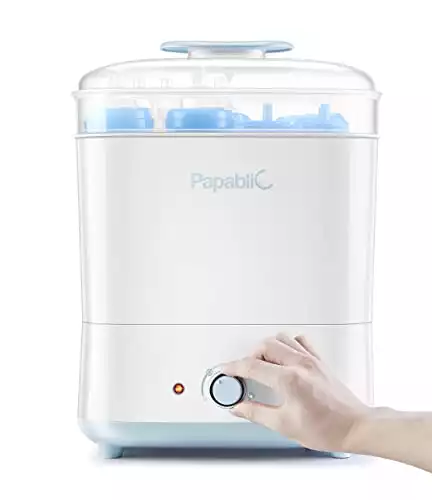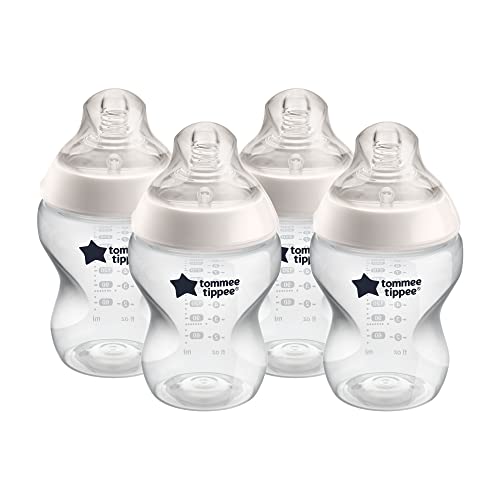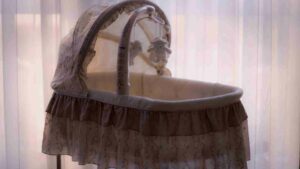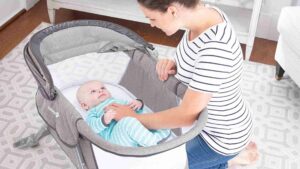You’ve reached the last few months of your pregnancy, and you’re about to become a new mom! Congratulations! But rather than enjoying this magical time in your life, you’re starting to worry about what you’re going to do when the baby is here.
As you’ve probably noticed, babies require a lot of stuff, and you might be panicking that you haven’t got it all, or you haven’t got enough.
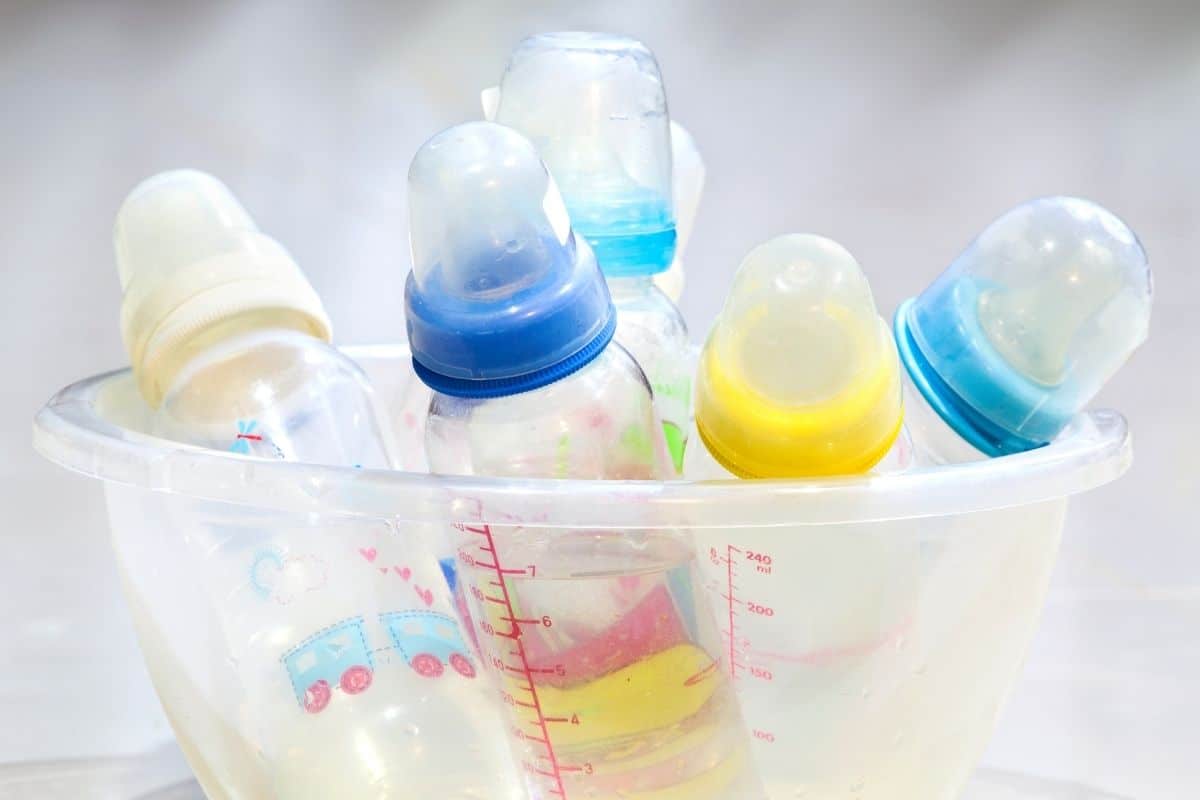
One issue in particular that can bother new mothers is just how many baby bottles are needed. Bottle feeding is an important part of development, but the ins and outs can be unfamiliar to a new mom.
No one wants to end up with too few bottles and a crying baby, but you also don’t want to go overboard. Especially with everything else you have to buy!
So, we’ve put together our guide on how many baby bottles you need for your little one. We’ll also help you choose which ones you should get, and why.
And if you’re still not sure where to start, we’ve even included some tips for buying and using. Read on to find out more!
How Many Baby Bottles Should I Buy?
There’s no clear answer to how many bottles you need to buy, as it depends on your own circumstances.
The first thing to consider when choosing bottle-feeding equipment is whether you plan to breastfeed as well. You also have to consider whether you’ll be staying at home, or if your child will be going to daycare.
When To Buy 2 Or 3 Bottles?
If you’re planning to breastfeed exclusively, and you’re a stay-at-home mom, then you don’t really need many bottles. Two or three bottles should be enough, as you’ll rarely use them.
Bottles are useful for occasions when you need to leave the house, or when you’re leaving your baby in another person’s care.
If you plan on breastfeeding as a stay-at-home mom, you might not think you need any bottles to start with. But it’s worth having two or three on hand because you never know what might come up.
When To Buy 3 To 6 Bottles?
If you’re a stay-at-home mom planning on using infant formula, you’ll need a few more bottles: roughly three to six. This will ensure you won’t need to clean bottles every time your baby needs a feed.
Bottles will need to be used multiple times a day, and having more of them simply reduces the stress of cleaning.
As a general rule, it’s better to have too many than too few. It can be surprisingly easy to run out of bottles when you’re dealing with a young child!
When To Buy 6 Bottles Or More?
For working moms, even more bottles are necessary. You’ll probably need more than six to make sure you have a large enough supply for when your little one is at daycare.
There has to be at least a bottle for every two hours, so you can leave for the day with enough food on hand for your child.
Again, assume you’ll need more bottles than you initially think. This way, when you finish work, you won’t have to immediately start cleaning bottles to ensure you have enough for an evening feed.
Choosing The Right Baby Bottles
One thing you’re sure to find as a new mother is just how much choice there is! Baby bottles are no exception. When it comes to choosing baby bottles, there are plenty of options available. Choosing the right one is a combination of several factors.
Plastic and glass baby bottles are both common, and you can also find bottles that combine the two materials. Glass bottles are good for newborns, as parents do the handling. This ensures the bottle is held securely and is less likely to drop and harm the baby.
Plastic bottles, on the other hand, are good for when babies are old enough to start holding the bottle by themselves.
They’re easier to hold, and they’re lighter. But you want to make sure the bottles are free from chemicals that might be harmful to the baby.
You can choose from different sizes, shapes, colors, and styles. Some bottles are designed specifically for newborns, while others are meant for growing toddlers.
The range can seem overwhelming, but it’s important to consider what features are necessary for your child.
Once you’ve chosen your bottles, they need to be given a good clean. Some baby bottles are dishwasher-safe, but others will need to be cleaned by hand. How easy to clean the bottles are might also affect the number you choose to buy.
Baby Bottles (And Accessories) Buyer’s Guide
Baby Bottle Material
There are two main types of baby bottles: plastic and glass. Both are very popular choices, and each has its own advantages and disadvantages. But these aren’t the only options on the market.
Glass
Glass bottles are great for newborns, as they’re easily handled, durable, and easy to clean. Glass is also BPA free, so it’s safe for use around little ones.
Glass shouldn’t be used by older babies and toddlers who can hold the bottle themselves, as if dropped, it can shatter. Glass bottles also tend to be more expensive than plastic, but not as expensive as some specialized materials.
Plastic
Plastic bottles are lightweight and inexpensive. They’re also shatterproof, so they can be handled by young children without any risk.
It’s important to ensure any plastic baby bottles are BPA-free, which means they don’t contain dangerous chemicals.
However, some parents are still nervous of potential chemicals in even BPA-free bottles. Plastic bottles are easy to buy, but they aren’t as long-lasting as other materials.
Stainless Steel
Stainless steel bottles are another option. These are often considered safer than regular plastic bottles because they’re made with non-toxic materials and less dangerous than glass.
However, they are expensive, and it can be hard to find matching accessories.
Silicone
Silicone is a durable and chemical-free alternative to plastic. These bottles are lightweight, and also very easy to clean. And because they withstand heat so well, they last significantly longer than plastic bottles.
Silicone bottles can be expensive, and it can be tricky to find matching accessories.
Bottle Shape

The shape of a bottle can have an impact on how much milk or formula it holds, and how easy to use it is. Most baby bottles are tall, with a curved shape. This shape is good for filling and drinking.
Baby bottles typically have ergonomic shaping. Ergonomics refers to the way something feels when you use it. Ergonomic holds are helpful for parents when and incredibly useful for babies when handling the bottle.
With an ergonomic hold, your growing child can begin to take control of their bottle. When choosing a bottle, look at whether it fits comfortably in your hands. If it doesn’t fit right, it won’t feel comfortable either during the many hours of feeding.
Some bottles have an angled neck, ideal for handling when feeding a baby. However, these options tend to be less popular because they’re harder to fill.
Wide-necked bottles may require slightly more care to use, but they’re much easier to measure baby formula with.
As well as the shape, you also need to consider the size. Bottles are often used on the go, so you want a shape that isn’t bulky to carry around.
Air Venting
When we eat and drink, we take in air. For babies, this can lead to gas, and potentially, colic. A venting system reduces the amount of air taken in during feeds, by either reducing the amount of air within the bottle or venting it through the nipple.
Some bottles have venting systems that pass the air through the bottle and out the base. Other bottles have special nipples to reduce the amount of air in each mouthful.
Gas and colic are unlikely to cause any lasting harm, but they are uncomfortable for the baby. Vented bottles help make feeds more comfortable for your little one.
Disposable Inserts
On the go, you might not have time to stop and clean your baby’s bottle between feeds. But carrying several bottles is inconvenient, and you’ll have even more washing to do at the end of the day. Disposable inserts are a great solution.
Disposable inserts are made of plastic. They can slide into the bottle, and be filled with breast milk or formula. When your baby has finished feeding, you can drop the insert into the trash.
The bottle nipple will need to be cleaned, but the bottle is good to go again. And it’s much easier to carry several spare bottle nipples, rather than several clean bottles.
Number And Size Of Bottles
As we mentioned above, how many baby bottles you need will depend on your own circumstances. You might find you only need two, or you might find you need more than ten bottles.
If you’re a breastfeeding stay-at-home mom, you probably won’t need many bottles at all. But if you prefer to use formula, then even stay-at-home moms will need a few extra bottles.
And if you’re a working parent, then you’ll need enough bottles for your infant to be fed throughout the day.
In terms of size, bottles are typically between 4 and 10 ounces. It’s best to use smaller, 4-ounce bottles for newborns, and change to larger bottles as the baby grows.
By the time your child is 4 months old, an 8-ounce bottle will probably be more convenient.
Bottle Nipple Materials
Baby bottle nipples are typically made of either silicone or latex. Latex has the advantage of being flexible and comfortable for babies to use, but it isn’t a very durable material. A latex nipple is likely to tear or degrade with regular use.
Also, some babies are allergic to latex, and it can cause a reaction. Silicone nipples are sturdy and durable, and they tend to hold the shape better. That’s why silicone is typically the better choice.
Bottle Nipple Shape
The shape of the nipple is important too. There are different types of nipples available. We’ve listed them below:
Classic bottle nipples have a bell shape or dome shape, with a narrow tip that contributes to a slow flow of milk. These are great for newborns and are the most cost-effective option.
You’ll also find that these nipples will fit onto most baby bottles. However, the slow milk flow might be frustrating for older children, or those with big appetites.
Flat-topped nipples are popular because they most closely resemble the mother’s breast. Flat-topped nipples are often used in combination with a wide base so that the nipple sits closer.
This shape is best for transitioning from breastfeeding to bottle-feeding. Most babies will also find this shape easier to feed on. But they’re difficult to clean and can be pricey.
Orthodontic nipples have flat and angled sides, with a bulb at the top. These are designed to fit more effectively into the baby’s mouth, and rest against the palate and tongue comfortably.
These nipples are recommended for teething babies. They’re gentle on the teeth and can promote better tooth formation. Unfortunately, they’re also quite expensive and not as readily available.
Single-Use Bottle Nipples
Single-use or disposable bottle nipples come prepackaged and sterilized and are ready for use on the go. They’re perfect for busy parents who might not always have the time for a total clean.
Single-use nipples are also ideal for traveling, camping, and other situations where you may not always have access to a sink and a sterilizing system.
A single-use bottle nipple simply has to be taken out of the package, attached to the bottle, and you’re ready to go! When your baby has finished, pop the nipple off, and throw it in the trash.
Combined with disposable inserts, single-use bottle nipples are perfect for long days out of the house.
Flow Speed
Nipple designs affect how fast the milk flows through the nipple. The slower the flow, the longer it takes for the baby to get all the milk they want. Too fast, and small babies might struggle to keep up.
Bottle nipples should be marked depending on their flow speed. The flow speed is typically determined by age. A slow flow is best for newborns, while toddlers will prefer a faster flow.
Of course, all babies are unique, and your child might prefer a flow speed different from their age limit. Speak to a pediatrician if you have any concerns about your child getting too much, or not enough, food.
Anything Else?
Bottles, nipples, and sterilizing equipment (which we’ll cover below), are the three things that most moms need. However, there are a couple of other items that might not be necessities but are certainly useful for the new mom.
Bottle warmers are particularly useful, as are insulated bags that allow the bottles to keep their heat on the go.
If your bottles are dishwasher safe, then you might want to invest in a dishwasher basket that will keep the bottle parts together as they’re washed. And once they’re done washing, a bottle drying rack will ensure everything dries properly.
Bottle Sterilizing Equipment
Sterilizing your bottles is an important part of ensuring that you don’t introduce bacteria into your baby’s food. During sterilization, no air is allowed into the bottle, so any germs inside will die. These are incredibly useful for new parents.
Not only does sterilizing equipment make cleaning easier, it also cleans better. A bottle sterilizer isn’t the only way to ensure your baby bottle is germ-free, but it’s definitely the quickest way to get peace of mind.
Baby Bottle Safety Tips
- Avoid cheap plastic bottles. They may save you money in the short term, but as they break easily, they’ll end up costing more.
- If you are buying a plastic bottle, make sure it’s BPA-free. Bottles that avoid harmful chemicals tend to be upfront and proud. If you can’t find any reference to chemicals being left out, then you probably want to avoid the brand.
- Plastic bottles shouldn’t be used in the dishwasher or microwave. The heat causes the plastic to begin breaking down, releasing microplastics.
- Baby bottle recalls do happen, so it’s best to keep an eye out for any news.
- Regularly check your bottles for cracks and damage. A bottle with a crack is more likely to break during use, which might harm the baby. Cracks are also a fantastic lurking-place for harmful bacteria.
- Pay attention to flow, and how much you’re feeding your baby. Overfeeding can lead to weight gain and health problems.
- Similarly, don’t add solid foods to baby formula. It’s really easy to overfeed when you’re bulking out the formula with extra food.
- Feeding introduces air to the gut, so it’s important to burp your infant after every feed. Once your baby has finished eating, gently place them on your shoulder, and rub their back.
Our Favorite Baby Bottles
Philips Avent Natural Baby Bottle
For newborns, we love the AVENT Natural Baby Bottle. The natural nipple shape encourages babies to latch, and the flexible material is comfortable for them to use.
Switching between breastfeeding and bottle feeding is easier with the AVENT Natural Baby Bottle.
An ergonomic shape allows parents to hold the bottle from any angle, while the air flex vents reduce feeding issues by venting air away from the baby’s tummy.
BPA-free, the slow flow of this design is ideal for little ones. We think that with the Phillips Natural Baby Bottle both parents and baby can enjoy a happy feeding time.
The brand is very popular with new moms because they continuously strive to improve their designs.
Tommee Tippee Closer To Nature Baby Bottle
The soft silicone nipple and ergonomic shaping of the Tommee Tippee Closer to Nature baby bottle make it an excellent choice for both breastfed and formula-fed infants.
The natural shaping encourages babies to latch, while the 3-way easy hold design helps parents to comfortably grip the bottle.
An anti-colic venting valve reduces the air intake, meaning the baby is less likely to feel uncomfortable after a feed. The slow flow nipple also reduces the amount of air intake and makes it easier to avoid overfeeding.
For newborns and younger infants, the Tommee Tippee is excellent. Available in glass, silicone, and BPA and phthalate-free plastic, the Tommee Tippee Closer to Nature Baby Bottle is perfect for all kinds of new moms.
MAM Easy Start Anti-Colic Bottle
Designed for growing babies, the MAM Easy Start Anti-Colic Bottle has a large shape and fast flow to accommodate big appetites.
Thanks to the vented base design, growing infants can drink more without swallowing excess air, reducing the risk of colic and reflux.
An elongated nipple mimics the feel of a natural breast, making it easier for babies to switch between breastfeeding and bottle-feeding.
There’s even a textured surface, to encourage latching. Moms will also appreciate the easy cleaning of this bottle and the self-sterilizing design. The bottle is germ-free after just a few minutes in the microwave.
Frequently Asked Questions
- How Often Do Babies Need To Be Fed?Newborns should be fed every 3 hours or as often as needed. As your baby grows, it'll need to be fed less frequently. Babies' appetites are always changing, and your feeding schedule will naturally adjust to their needs. If you have any worries about how much or little your baby is eating, speak to your pediatrician.
- Do Baby Bottles Need Regular Replacing?Baby bottles only really need to be replaced if they have a fault. Make sure to regularly check for cracks, scratches, and other damage. The other time you may need to replace the bottle, or just the nipple, is if it no longer meets the needs of your growing child.
- How Do You Clean A Baby Bottle?Baby bottles need to be cleaned with warm water and soap, and dried completely. Some baby bottles are dishwasher-safe, but make sure to double-check the packaging. Sterilization is the best way to clean a bottle, but it only needs to be done occasionally. Sterilizing equipment is useful for busy moms, and some bottles are self-sterilizing. Another way to sterilize is to soak the bottle in boiling water for several minutes.
- How Many Baby Bottles Do New Moms Need?Most new moms will need between 2 and 6 baby bottles. Breastfeeding moms will need around 2 to 3, while formula-feeding moms should have 3 to 5. Stay-at-home moms will need a smaller amount than working moms. A working mom should have one bottle for roughly every two hours of daycare. Some moms will prefer to have spare bottles on hand to avoid excess cleaning. Disposable inserts and nipples can also be used to bulk out the number of bottles on hand without having to buy extra. These single-use items are safe to use on the go, and should be thrown in the trash at the end of feeding time.
- I've Had Another Baby, Can I Reuse Old Baby Bottles?As long as the baby bottles are undamaged, it's fine to reuse them for another baby. Especially if your first child found the bottles comfortable and easy to use! Good baby bottles are durable and can withstand plenty of use, and regular cleaning will prevent germs from growing. Before using them for another baby, make sure to sterilize them to remove any lingering bacteria.
Final Thoughts: How Many Baby Bottles For New Moms?
The number of baby bottles you need depends on what type of feedings you plan to do. Formula-feeding moms will need more bottles than breastfeeding moms, and working moms will need more bottles than stay-at-home moms.
Most moms should be happy starting with two and adding more as you and your baby’s needs change!
The number isn’t the only factor you need to consider. The material, shape, and nipple design are all important considerations. But don’t panic. It might seem overwhelming, but we’re certain you’ll make the right choice for you and your child!

Carly Link, a 33-year old mother of two toddlers. She is a parent and goes through a lot of the usual parenting difficulties herself. Carly shares all her experiences and knowledge about the best baby products through this blog.

